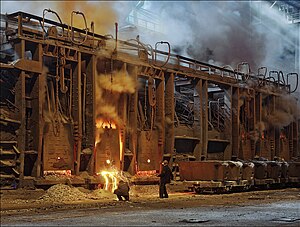
Back فرن المجمرة المكشوفة Arabic Forn Martin-Siemens Catalan Siemensova–Martinova pec Czech Siemens-Martin-processen Danish Siemens-Martin-Verfahren German Forno de Siemens-Martin Esperanto Horno de solera Spanish کوره بلند روباز Persian Siemens-Martin-prosessi Finnish Procédé Martin-Siemens French


An open-hearth furnace or open hearth furnace is any of several kinds of industrial furnace in which excess carbon and other impurities are burnt out of pig iron to produce steel.[1] Because steel is difficult to manufacture owing to its high melting point, normal fuels and furnaces were insufficient for mass production of steel, and the open-hearth type of furnace was one of several technologies developed in the nineteenth century to overcome this difficulty. Compared with the Bessemer process, which it displaced, its main advantages were that it did not expose the steel to excessive nitrogen[clarification needed] (which would cause the steel to become brittle), was easier to control, and permitted the melting and refining of large amounts of scrap iron and steel.[2]
The open-hearth furnace was first developed by German-born engineer Carl Wilhelm Siemens. In 1865, the French engineer Pierre-Émile Martin took out a licence from Siemens and first applied his regenerative furnace for making steel. Their process was known as the Siemens–Martin process or Martin–Siemens process, and the furnace as an "open-hearth" furnace. Most open hearth furnaces were closed by the early 1990s, not least because of their slow operation, being replaced by the basic oxygen furnace or electric arc furnace.[2]
Whereas the earliest example of open-hearth steelmaking is found about 2000 years ago in the culture of the Haya people, in present day Tanzania,[3] and in Europe in the Catalan forge, invented in Spain in the 8th century, it is usual to confine the term to certain 19th-century and later steelmaking processes, thus excluding bloomeries (including the Catalan forge), finery forges, and puddling furnaces from its application.
- ^ K. Barraclough, Steelmaking 1850-1900 (Institute of Metals, London 1990), 137-203.
- ^ a b Philippe Mioche, « Et l'acier créa l'Europe », Matériaux pour l'histoire de notre temps, vol. 47, 1997, p. 29-36
- ^ Avery, Donald; Schmidt, Peter (1978). "Complex Iron Smelting and Prehistoric Culture in Tanzania". Science. 201 (4361): 1085–1089. Bibcode:1978Sci...201.1085S. doi:10.1126/science.201.4361.1085. ISSN 0036-8075. JSTOR 1746308. PMID 17830304. S2CID 37926350.
© MMXXIII Rich X Search. We shall prevail. All rights reserved. Rich X Search